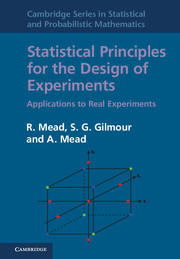Book contents
- Frontmatter
- Contents
- Preface
- Part I Overture
- 1 Introduction
- 2 Elementary ideas of blocking: the randomised complete block design
- 3 Elementary ideas of treatment structure
- 4 General principles of linear models for the analysis of experimental data
- Part II First subject
- Part III Second subject
- Part IV Coda
- References
- Index
4 - General principles of linear models for the analysis of experimental data
from Part I - Overture
Published online by Cambridge University Press: 05 November 2012
- Frontmatter
- Contents
- Preface
- Part I Overture
- 1 Introduction
- 2 Elementary ideas of blocking: the randomised complete block design
- 3 Elementary ideas of treatment structure
- 4 General principles of linear models for the analysis of experimental data
- Part II First subject
- Part III Second subject
- Part IV Coda
- References
- Index
Summary
Introduction and some examples
In this chapter we consider the principles on which the classical analysis of experimental data is based. The explanation of these principles necessarily involves mathematical terminology, but in the main part of the chapter this will be reduced as far as possible so that the results will hopefully be appreciated by readers without a sophisticated mathematical background. The formal mathematical derivation of results is included in the appendix to this chapter, the numbering of sections in the appendix matching the section numbering in the main body of the chapter. The discussion of general principles will be illustrated by reference to five examples of data. Two of the examples have already been seen in the two previous chapters.
Example A is the randomised block design with ten spacing treatments for rice in four blocks of ten plots each, for which the yield data are given in Section 2.2. The interest in this example is in the relative magnitude of the treatment effects, the block effects and the residual variation, and also in the relationship between yield and spacing.
Example B is the experiment on the water uptake of amphibia, described in Section 3.4, in which eight treatment combinations were replicated twice each. The interest in this example is in the separation of the different components of treatment variation, using the factorial structure of the eight treatments.
Example C is an experiment on tomatoes in which five spray treatments using a chemical growth regulator were compared. Thirty plots were used, arranged in six rows and five columns. The results were as shown in Table 4.1. The analysis must allow for systematic differences between rows and between columns, while being principally concerned with the differences between the five treatments for which the questions are concerned with the general effect of spraying with the growth regulator, and the particular factorial comparisons of the first four treatments.
- Type
- Chapter
- Information
- Statistical Principles for the Design of ExperimentsApplications to Real Experiments, pp. 42 - 104Publisher: Cambridge University PressPrint publication year: 2012

